The Great 1080p HDTV Face Off JVC HD-56FH96
Brightness. Smoothness.
As the indirect successor to our 2005 Best RPTV RAVE Award winner, it wasn't a surprise that the JVC did so well. What was surprising is that it tied for second place despite having the worst contrast ratio, the highest black level, and, in its highest contrast-ratio mode, the lowest overall light output. Just as the Samsung's excellent measurements don't tell the whole story, the JVC's relatively poor measurements don't, either.
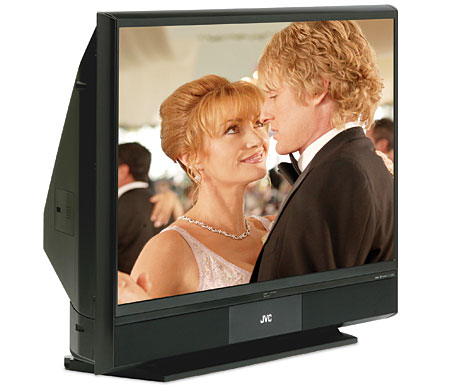
The Fifth Element portion of the test revealed the first area in which the JVC was superior to just about every other TV in the Face Off. In chapter 5, there was very little noise in the shadows behind Brucey's face. John commented that the overall image had "very little grain to it."
Most of the judges felt that the image was a little softer than the other TVs, but not badly so. Nikhil felt it was a sort of "pleasant" softness. As he disliked the Samsung's artificial detail the most, it's not surprising he liked this direction better.
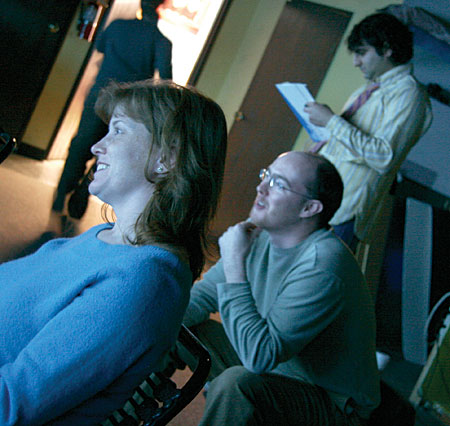
On the processing side, the JVC was just south of mid-pack. Its 3:2 pickup was a little slow but not as bad as some of the others. The same was true of the video processing. There were some jagged edges, but it was better than some and worse than some in this regard.
 While the black level was the worst in the Face Off it wasn't high enough to bother anyone. At 0.058 ft-L, it is still lower than just about every direct-view LCD and many plasmas. It's also less than half the black level of the last JVC HD-ILA RPTV we reviewed. With its iris set for the best contrast ratio, the overall light output was 91 ft-L, or about 9 percent lower than the next lowest (the Toshiba). With its iris fully open, it is capable of an eye clinching 216.5 ft-L, which is a truly startling amount of light from a 56-inch display. I mean deer-in-the-headlights startling.
While the black level was the worst in the Face Off it wasn't high enough to bother anyone. At 0.058 ft-L, it is still lower than just about every direct-view LCD and many plasmas. It's also less than half the black level of the last JVC HD-ILA RPTV we reviewed. With its iris set for the best contrast ratio, the overall light output was 91 ft-L, or about 9 percent lower than the next lowest (the Toshiba). With its iris fully open, it is capable of an eye clinching 216.5 ft-L, which is a truly startling amount of light from a 56-inch display. I mean deer-in-the-headlights startling.
The color points were off by about as much as the Toshiba and the Sony. Each of the judges made a comment about the color in one way or another, but none felt that it was a big issue.
The remote is the same that has come with every JVC RPTV in the last few years. It's backlit and has tons of buttons, but none of them are direct input access.
While all RPTVs (in this Face Off and in general) produce some amount of noise in the screen itself, our judges only commented on this point with the JVC. Adrienne called it a sort of "sheen" but said that moving back just a few inches removed it from view.
Mostly, the JVC earned its place by having a relatively low-noise picture and by not doing anything really wrong. Its exceptional brightness makes this an easy choice for a TV that does double duty on any given Sunday.
Highlights
• Able to melt your eyes with light (or not)
• Admirably low noise
At A Glance: JVC HD-56FH96 Rear-projection HDTV
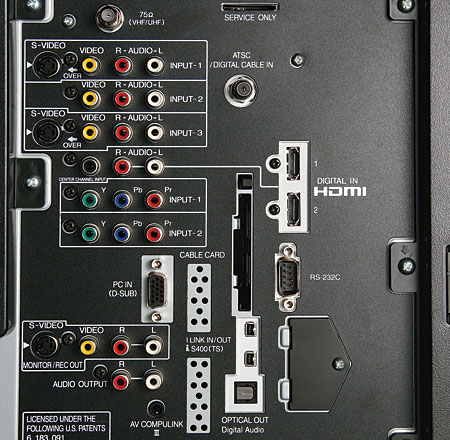
Connections
Inputs:
Video: HDMI (2), RGB D-Sub 15 (1), component video (2), S-video (3), composite video (4)
Audio: stereo analog (4), center channel input (1)
Outputs:
Video: S-video (1), composite (1)
Audio: Optical (1), stereo analog (2)
Additional: FireWire (2), RS-232 (1), RF (2), CableCARD (1), Compulink (1)
Features
Ratings: JVC HD-56FH96 Rear-Projection HDTV
Build Quality: 92
Value: 88
Features: 91
Performance: 92
Ergonomics: 90
Overall Rating: 91
General Information
HT Labs Measures: JVC HD-56FH96 Rear-Projection HDTV
Full-On/Full-Off Contrast Ratio—1570:1;
Measured Resolution with the Leader LT-446:
DC Restoration (poor, average, good, excellent): Average (In Theater Pro mode)
Color Decoder (poor, average, good, excellent): Excellent
Measured Color Points:
The left chart shows the HD-56FH96's gray scale relative to its color temperature at various levels of intensity, or brightness (20 IRE is dark gray; 100 IRE is bright white). The gray scale as set by the factory, in the low color-temperature mode measures cool with dark images and warm with brighter images. After making adjustments using the Photo Research PR-650, the gray scale measures sort of better, within 809 Kelvin of D6500, the accurate color temperature, across the entire range.
The right chart shows the gray scale (or color temperature) relative to the color points of the display's red, green, and blue LCOS chips. These are off those specified by SMPTE. Red is slightly oversaturated and very slightly reddish-orange. Blue is slightly oversaturated. Green is very oversaturated.
After calibration, and using a full-field 100-IRE white (91.04 foot-lamberts) and a full-field 0-IRE black (0.058 ft-L), the contrast ratio was 1,070:1. Using a 16-box checkerboard pattern (ANSI contrast), the contrast ratio was 208:1. The best contrast ratio was achieved in the Theater setting. The brightest image was achieved in the Dynamic setting and produced 216.5 ft-L with a 100-IRE white and 0.186 ft-L with a 0-IRE black, a contrast ratio of 1164:1—GM
Type: LCOS (HD-ILA)
Screen Size (diagonal): 56 inches
Native Resolution: 1,920 by 1,080
Lamp Life: 7,500 hours
Dimensions (H x W x D, inches): 38.13 x 52 x 17.13
Price: $4,500
HD-56FH96 Rear-Projection HDTV, $4,500
JVC
(800) 252-5722
www.jvc.com
Dealer Locator Code JVC
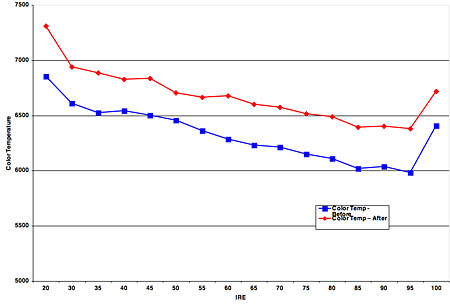
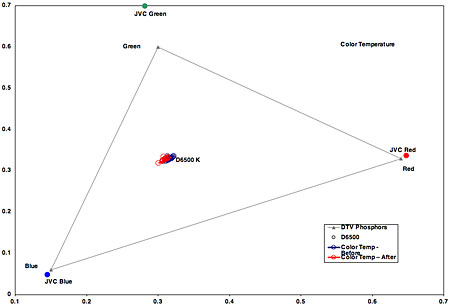
ANSI Contrast Ratio—208:1
480: 480 (per picture height)
720p: 720 (pph)
1080i: 1080 (pph)
Red Color Point: x=0.648, y=0.337
Green Color Point: x=0.282, y=0.699
Blue Color Point: x=0.145, y=0.048





























































